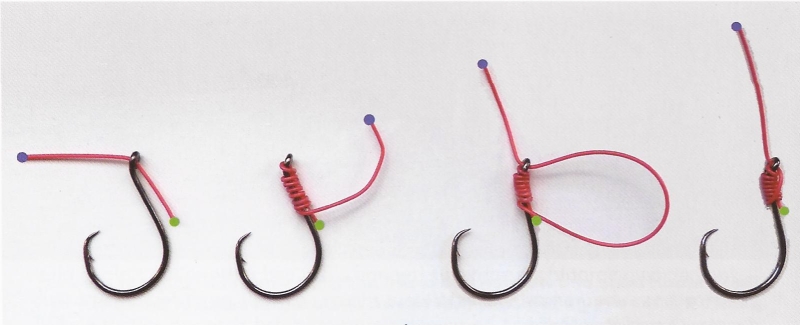 Kent Coast Sea Fishing Compendium |
Hook Snelling |

Extensive research has found that the type of fishing hook knots used has a significant effect on catch rates. Circle hooks with a snell knot [1] were found to have the highest catch rate by a considerable margin and caught more than twice as many fish as either O'Shaugnessy and Octopus patterned hooks of the same size.
Circle hooks must be snelled (as shown) to get the better catch rate. The method of tying fishing hooks was also investigated and a difference in catch rate between tying a circle hook versus snelling a circle hook was determined to be around 20% in favour of the snell knot.
Besides improved catch rates, the snell knot takes only seconds per hook to tie and the resulting knot is reputedly the strongest of all saltwater fishing hook knots. In contrast, tying to the eye of the hook weakens the trace by as much as 40% (depending on the knot used and the skill of the fisherman tying the knot).
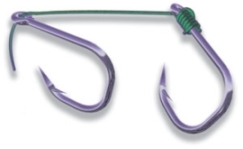
- First pass the trace through the eye of the hook from the front of the hook. Only pass it through about half an inch
- Hold the shank of the hook and the half inch tab end and wrap the trace around both the shank of the hook and the tab end 7 or 8 turns
- Pass the trace back down through the eye of the hook from the back of the hook
- Pull the trace tight while holding the hook to set the snell
- There should be very little or no tag end protruding when the knot is set.
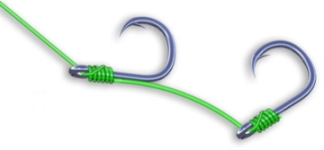
If the hook curls up towards the trace you have snelled the hook correctly. Snelling a hook like this makes the trace act as a spring and improves the hook set rate and also prevents the fish from throwing the hook.
To tie a two hook rig, simply snell the first hook on, then pass the end of the trace through the back of the second hook and you are ready to snell the second hook on. Set the distance between the hooks at about two thirds of the length of the bait fish you intend to use before snelling the second hook.
When tying a two hook rig, keeping the hooks in line further improves both the catch rate and the ability of the rig to hold soft or live baits. If using whole fish baits, put one hook through the head and the other hook through the body behind the gut cavity and make sure the second hook goes around the spine of the bait fish. The head of the bait should be on the bottom hook.
[1] Editor's note: the snell is actually a hitch knot or wrap which, unlike all other fishing knots (save for the Bimini Twist and, when properly tied, the Palomar Knot), provides 100% line strength.
The last few years have seen circle hooks become increasingly popular in the UK, although most anglers still use the traditional J-shaped hooks. With circle hooks there is no need to strike in the traditional way. Instead, the angler just needs to reel in normally and the hook will be pulled into the corner of the fishes mouth and lip hook the fish. Alternatively, fish often hook themselves on circle hooks by taking a bait and then swimming away with it in their mouth, causing the hook to slide to the edge of the fishes mouth and hook itself there. Commercial long-lines which leave thousands of hooks unattended in the sea for 24-hours or longer have used circle hooks for decades due to the self-hooking ability. An additional advantage of circle hooks is that they almost always lip hook fish – perfect in these days of catch and release fishing. Circle hooks are massively popular in the USA and parts of Europe, and while they have gone up in popularity in the UK anglers using them are still in the minority, with some angers pointing to the difficulty in presenting worm baits on them as a reason why they have not fully caught on.
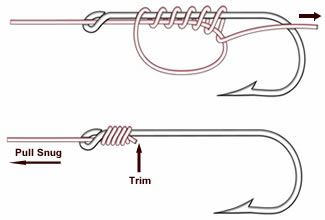 |
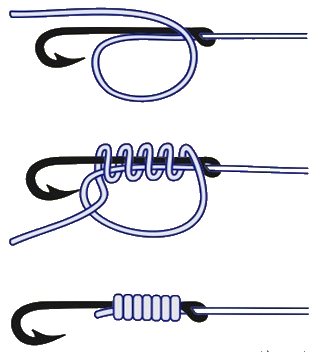 |
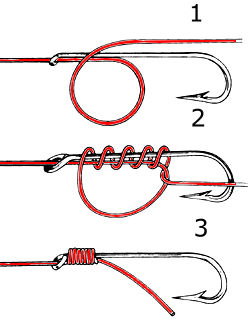 |
Fishing Knot App reviews by www.outdoorstime.com
"The Beach Fisherman's Compendium" (1990) John Holden at pages 185, 186, 187 & 191
Snelled Hooks
… A traditional favourite of commercial fishermen, the spadehook/snell combination is much faster to tie than a plain shank whipping (which can be used on a spade end hook if you prefer) … one advantage of the system is that it holds the hook shank straight out from the trace, whereas an eyed hook tends to fold. Sometimes bait presentation is enhanced by a straight joint, and in those circumstances a snell is preferred. Spade ends are not necessary; the hitch can be tied just as easily on an eyed hook. Either treat the eye as an ordinary spade, or thread line through beforehand. As long as the trace nylon is fairly thin, a snell will not damage threaded worms.
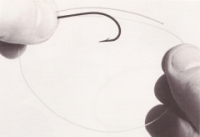 |
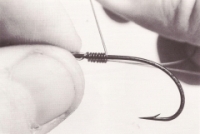 |
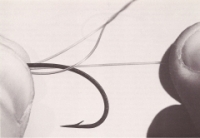 |
| Fold a loop about 6 inches in diameter and lay it alongside the hook shank. | Hold the left hand end of the loop between right finger and thumb and whip it neatly around the shank and double strands of nylon. Put in at least 6 full turns. | Carefully slide your left finger and thumb over the coils and pinch them to the shank. Now pull on the spare end of nylon to tighten the knot. |
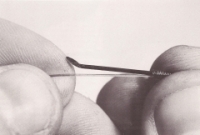 |
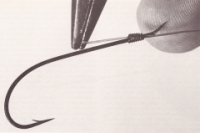 |
|
| Swap over your hands so that right finger and thumb now hold the knot coils. Pull on the snood to further tighten the knot. | Slide the knot close to the spade end. Pull the knot tight with pliers. Finally, trim the loose end. |
"Choose Your Weapons" Phill Williams at pages 32 & 33, Boat Fishing Magazine, Issue 126, February 2012
Deep hooking accidents through mistimed strikes do occasionally happen, particularly when fish gulp baits down or are left biting for too long, resulting in hooks being taken so far down that they can't easily be retrieved …
That isn't much of a problem with fish you intend to keep, providing you dispatch them properly first. It's the inedible, undersized and surplus-to-requirements fish that are the problem here.
Time out of the water, efficiency of disgorging and, in the case of shark species such as tope, handling them in a way that supports their body cavity so as not to rupture vital blood vessels to their internal organs, is what makes the difference.
Putting a fish back into the water and watching it 'swim' away isn't necessarily the same as putting it back to live … Part of the answer lies in minimising time spent out of the water. In that regard, speed and efficiency of disgorging with a minimum of fuss is key, along with avoiding tissue damage or blood loss. And the way to this is with carefully thought through hook choice.
The ideal scenario would be to hook every fish in the scissor or corner of its mouth, allowing the hook to be recovered quickly without risk to either the gills or the back of the throat. Something which, when using circle hooks, you can be pretty much assured of doing fish after fish.
The direction of the point, bend of the shank, and often the angle of the eye are designed specifically so that even if the bait is swallowed, because the in-pointing hook tip is angled away from any flesh, it is unlikely to be in a position to make contact.
Even when pressure is applied down the line, because of the unique design, which at face value looks incapable of hooking anything, the tip still cannot get a grip. Instead, it acts like the runner on a sledge allowing it to slide harmlessly over the inner parts of the mouth. Only as the shank starts to exit the mouth and the hook is pulled around is it able, for the first time, to take hold, which invariably happens in the corner or scissor of the mouth, because that's the furthest point back as the fish swims away.
But, unfortunately, it isn't quite as simple as that because the use of circle hooks doesn't suit all baits, though they are good for all species. Where the plan can come unstuck a little is for those situations where worm baits are favoured, which need to be threaded up over the hook and on to the mono of the trace. Getting worms onto circle hooks can be done, but it certainly isn't straightforward nor easy.
Squid and fish baits are another matter and can be much more readily managed. One way around the worm bait problem would be to use the lugworm sausage method … which gives you more worm to work the hook through. Alternatively, lash the bait to the hook with elasticised thread.
"Operation Sea Angler: The Second Wave" (2013) Mike Ladle & Steve Pitts at pages 41, 190 to 195
Bream and Wrasse
Circle hooks for bream ?
We are now devotees of circle hooks. They are very effective and save the lives of quite a few fish because they lip-hook virtually everything, without the angler needing to strike to set the hook … All in all, it seems that a decent-sized circle hook is not only best for hooking the fish that bite, but it also gives those released a much better chance of survival.
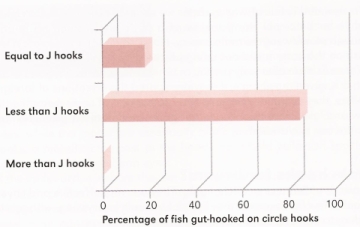 |
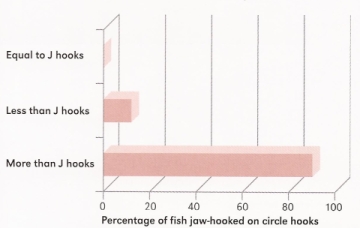 |
Far fewer fish will be gut-hooked on circle hooks than J hooks | Many more fish are jaw-hooked on circle hooks compared with J hooks |
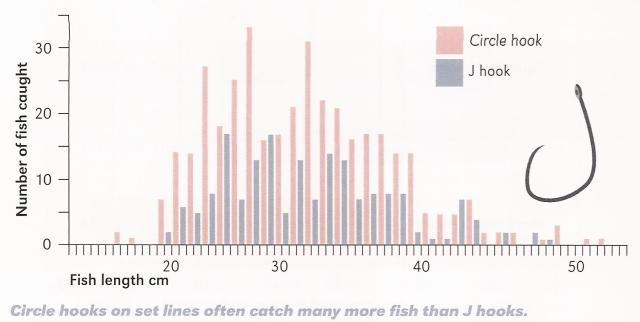
Hooks and Weights: the vital links
Circle hooks
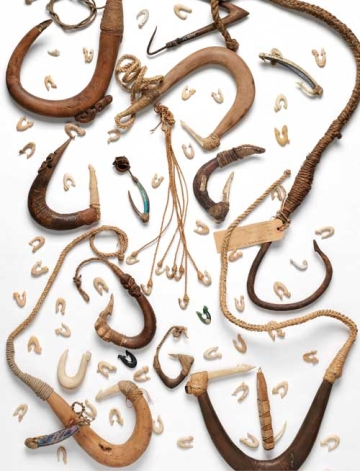
… there is nothing new fangled about this type of hook. The first reference that we have to their use is from 1897. A good example of the traditional use of circle hooks is to be seen in New Zealand where many of the Maori fish hooks are circles. Clearly these bone and wooden hooks are not … 'sharp in the point'. Rather, it is the principle of the design that works and because circle hooks catch in the corner of the mouth and stay there, they have been a success for hundreds, if not thousands of years …
Canadian researchers Cooke and Suski recently gave an excellent account of scientific study into the benefits of circle hooks. The gist of the results is that:
- More fish were jaw-hooked when using circle hooks.
- Mortalities were consistently lower for circle hooks than for J hooks.
Circle hooks seem to be most effective when used with live or dead baits. They are probably not particularly good as fly hooks, or when attached to artificial lures …
… anyone who is not using these hooks for bait fishing by now is certainly missing the boat.
The (New Zealand) study … involved setting long-lines to catch snapper. There are popular sport fish with large, toothy, bony mouths similar in general form to the mouth of a bass or cod so the results almost certainly apply to fish like these and probably many others. The set lines were fitted with 4/0 or 5/0 hooks and baited with pilchards and the trial involved 60,000 baited hooks in all … On each line the alternate hooks were circle or J hooks (of two types) … In one test the circle hooks caught 507 snapper and the same number of J hooks caught only 317. This is an increase of almost 60%. Even more significant is the fact that in this test the circle hooks did not gut-hook any small (12in) fish, while the J hooks gut-hooked 47 - that's 15% … for anglers (particularly match anglers) this could be a massive bonus.
In addition to the hook comparison, two methods of tying the hook to the trace were compared. Results of this test were even more startling. Circle hooks tied with a Snell knot … caught 40% more snapper than circles tied with a half blood knot and … three times as many fish as J hooks in whatever manner the latter were tied.
… if an angler holds the rod, waits for bites and strikes effectively … then the circle hook may lose its advantage. However … many of the modern methods (distance casting, some match fishing, uptiding etc) already rely on the fish hooking themselves against the resistance of a grip lead or fixed weight of some sort. This … is almost the same as a hook fished on a long-line. So the improved hooking power shown by circle hooks should be a huge advantage for the 'wait-for-a-fish-to-hook-itself' approach.
Finally, whether the hooks are better or not as fish catchers, one thing is certain … you will deeply hook a lot less fish by using circle hooks …
